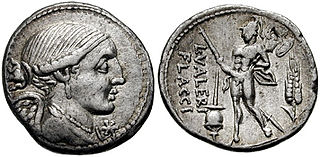Related Research Articles

The gens Petronia was a plebeian family at ancient Rome. This gens claimed an ancient lineage, as a Petronius Sabinus is mentioned in the time of Lucius Tarquinius Superbus, the last of the Roman kings, but few Petronii are mentioned in the time of the Republic. They are frequently encountered under the Empire, holding numerous consulships, and eventually obtaining the Empire itself during the brief reign of Petronius Maximus in AD 455.

The gens Valeria was a patrician family at ancient Rome, prominent from the very beginning of the Republic to the latest period of the Empire. Publius Valerius Poplicola was one of the consuls in 509 BC, the year that saw the overthrow of the Tarquins, and the members of his family were among the most celebrated statesmen and generals at the beginning of the Republic. Over the next ten centuries, few gentes produced as many distinguished men, and at every period the name of Valerius was constantly to be found in the lists of annual magistrates, and held in the highest honour. Several of the emperors claimed descent from the Valerii, whose name they bore as part of their official nomenclature.
Publius Pomponius Secundus was a distinguished statesman and poet in the reigns of Tiberius, Caligula, and Claudius. He was suffect consul for the nundinium of January to June 44, succeeding the ordinary consul Gaius Sallustius Crispus Passienus and as the colleague of the other ordinary consul, Titus Statilius Taurus. Publius was on intimate terms with the elder Pliny, who wrote a biography of him, now lost.
Quintus Pomponius Secundus was a Roman aristocrat of the first century, and consul suffectus in AD 41 as the colleague of Gnaeus Sentius Saturninus. His brother was the poet and statesman Publius Pomponius Secundus, and their half-sister, Milonia Caesonia, was the second wife of the emperor Caligula.
The gens Terentia was a plebeian family at ancient Rome. Dionysius mentions a Gaius Terentius Arsa, tribune of the plebs in 462 BC, but Livy calls him Terentilius, and from inscriptions this would seem to be a separate gens. No other Terentii appear in history until the time of the Second Punic War. Gaius Terentius Varro, one of the Roman commanders at the Battle of Cannae in 216 BC, was the first to hold the consulship. Members of this family are found as late as the third century AD.

The gens Vibia was a plebeian family at ancient Rome. Although individuals named Vibius appear in history during the time of the Second Punic War, no members of this gens are found at Rome until the final century of the Republic. The first of the Vibii to obtain the consulship was Gaius Vibius Pansa in 43 BC, and from then until imperial times the Vibii regularly filled the highest offices of the Roman state. The emperors Trebonianus Gallus and Volusianus each claimed descent from the family.

The gens Antonia was a Roman family of great antiquity, with both patrician and plebeian branches. The first of the gens to achieve prominence was Titus Antonius Merenda, one of the second group of Decemviri called, in 450 BC, to help draft what became the Law of the Twelve Tables. The most prominent member of the gens was Marcus Antonius.
The gens Arruntia was a plebeian family at ancient Rome. Members of this gens first came to prominence during the final years of the Republic.
The gens Caecinia was a plebeian family of Etruscan origin at ancient Rome. Members of this gens are first mentioned in the time of Cicero, and they remained prominent through the first century of the Empire, before fading into obscurity in the time of the Flavian emperors. A family of this name rose to prominence once more at the beginning of the fifth century.
The gens Titia was a plebeian family at ancient Rome. The gens is rarely mentioned in the Republican period, and did not rise out of obscurity till a very late time. None of its members obtained the consulship under the Republic, and the first person of the name who held this office was Marcus Titius in BC 31.
The gens Cestia was a plebeian family at ancient Rome during the later Republic, and in imperial times. The first member of the gens to obtain the consulship was Gaius Cestius Gallus in AD 35. The family's name is commemorated on two monuments, the Pons Cestius and the Pyramid of Cestius which survive into modern times.
The gens Cluvia was a plebeian family at ancient Rome, known from the later Republic, and early imperial times. The first member of the gens to achieve prominence was Gaius Cluvius Saxula, praetor in 175 and 173 BC.

The gens Plautia, sometimes written Plotia, was a plebeian family at ancient Rome. Members of this gens first appear in history in the middle of the fourth century BC, when Gaius Plautius Proculus obtained the consulship soon after that magistracy was opened to the plebeian order by the Licinio-Sextian rogations. Little is heard of the Plautii from the period of the Samnite Wars down to the late second century BC, but from then to imperial times they regularly held the consulship and other offices of importance. In the first century AD, the emperor Claudius, whose first wife was a member of this family, granted patrician status to one branch of the Plautii.
The gens Bellicia was an aristocratic plebeian family at ancient Rome, which flourished during the first and second centuries. The Bellicii rose to prominence from Gallia Narbonensis, attaining senatorial status with Gaius Bellicius Natalis, who was appointed consul suffectus in AD 68.
The gens Raecia, also spelled Racia, was a minor plebeian family at ancient Rome. Members of this gens are first mentioned at the time of the Second Punic War. Marcus Raecius was praetor in 170 BC. However, after this the family fell into obscurity until imperial times.
The gens Rubria was a plebeian family at ancient Rome. Members of this gens are first mentioned in the time of the Gracchi, but they did not rise to prominence until imperial times. The first of the Rubrii to obtain the consulship was Rubrius Gallus, some time before AD 68.
The gens Sallustia, occasionally written Salustia, was a plebeian family at ancient Rome. Members of this gens are first mentioned in the time of Cicero, and from that time they attained particular distinction as statesmen and writers. The most illustrious of the family was the historian Gaius Sallustius Crispus, who wrote valuable works on the Jugurthine War and the Conspiracy of Catiline, which still exist.
The gens Seia was a minor plebeian family of equestrian rank at ancient Rome. Members of this gens are first mentioned in the time of Cicero, and a few of them held various magistracies under the late Republic and into imperial times.
The gens Silia was a plebeian family at ancient Rome. Members of this gens are mentioned as early as the fifth century BC, but first to hold the consulship was Publius Silius Nerva, in the time of Augustus. The Silii remained prominent until the time of the Severan dynasty, in the early third century.
The gens Trebonia, rarely Terebonia, was a plebeian family at ancient Rome. Members of this gens are mentioned in the first century of the Republic, and regularly throughout Roman history, but none of them attained the consulship until the time of Caesar.
References
- 1 2 Dictionary of Greek and Roman Biography and Mythology, vol. III, p. 689 ("Calvisius Sabinus").
- 1 2 3 4 Dixon, p. 225.
- 1 2 Chase, p. 110.
- ↑ Syme, "P. Calvisius Ruso", pp. 189 ff.
- ↑ Syme, "P. Calvisius Ruso", p. 190.
- 1 2 Chase, p. 113, 114.
- ↑ Caesar, De Bello Civili, iii. 34, 35.
- ↑ Appian, Bellum Civile, ii. 60, v. 81, 96, 132.
- ↑ Cicero, Philippicae, iii. 10, Epistulae ad Familiares, xii. 25.
- ↑ Cassius Dio, xlviii. 34, 46.
- ↑ Plutarch, "The Life of Marcus Antonius", 58.
- ↑ Broughton, vol. II.
- ↑ Fasti Magistrorum Vici, CIL VI, 10286.
- ↑ Fasti Lucerini, CIL IX, 786.
- ↑ Setälä, p. 71
- ↑ Tacitus, Annales, iv. 46, vi. 9, Historiae, i. 48.
- ↑ Cassius Dio, lix. 18.
- ↑ Tacitus, Annales, v. 8, vi. 18, xi. 13, xii. 27, 28, Dialogus de Oratoribus, 13.
- ↑ Cassius Dio, lix. 6, 29.
- ↑ Quintilian, x. 1. § 98.
- ↑ Pliny the Elder, vii. 19, xiii. 12. s. 26, xiv. 4. s. 6.
- ↑ Pliny the Younger, Epistulae, iii. 5, vii. 17.
- 1 2 Fasti Ostienses , CIL XIV, 244.
- ↑ Gallivan, "The Fasti for the Reign of Claudius".
- ↑ Fasti Septempedani, AE 1998, 419.
- ↑ Gallivan, "The Fasti for A.D. 70–96".
- ↑ Smallwood.
- ↑ Geoffrey William Adams (2013). Marcus Aurelius in the Historia Augusta and Beyond. Rowman & Littlefield. pp. 57–. ISBN 978-0-7391-7638-2.
- ↑ Pliny the Younger, Epistulae, i. 12. § 12, ii. 20, iii. 1, 19; iv. 4, 1; v. 7; viii. 2; ix. 6.
- 1 2 Jeffers, p. 52
- ↑ Birley, The Fasti of Roman Britain, pp. 193 ff.
- ↑ Seneca the Younger, Epistulae, 27.